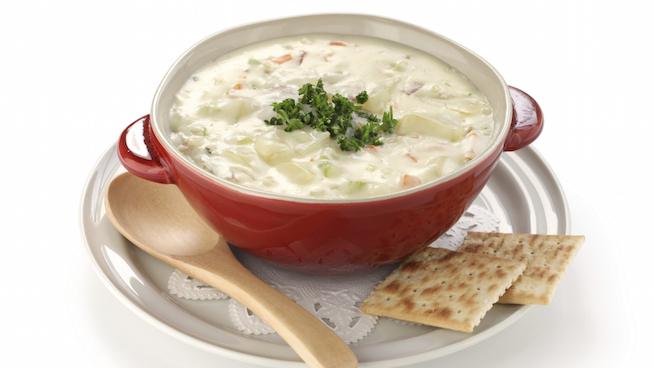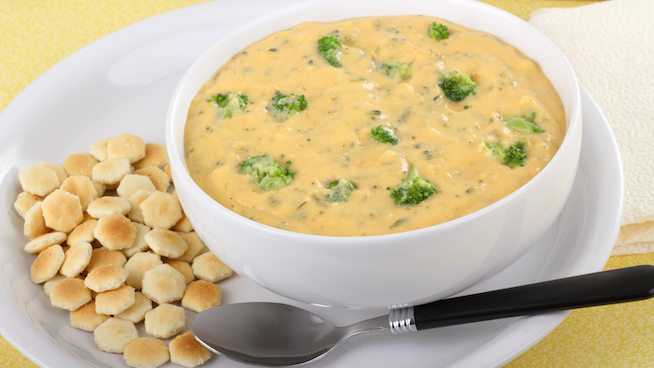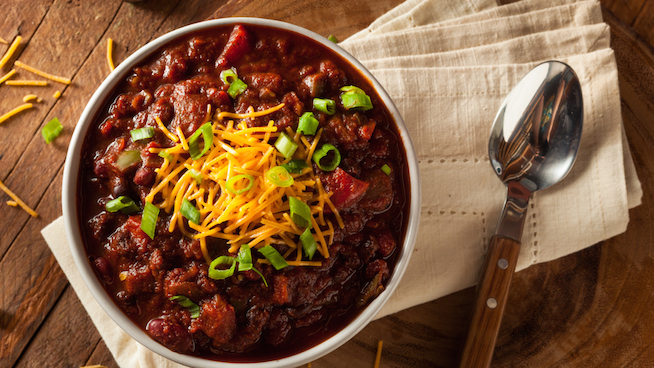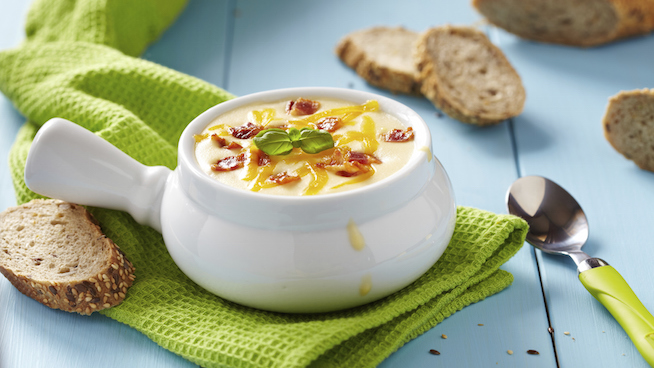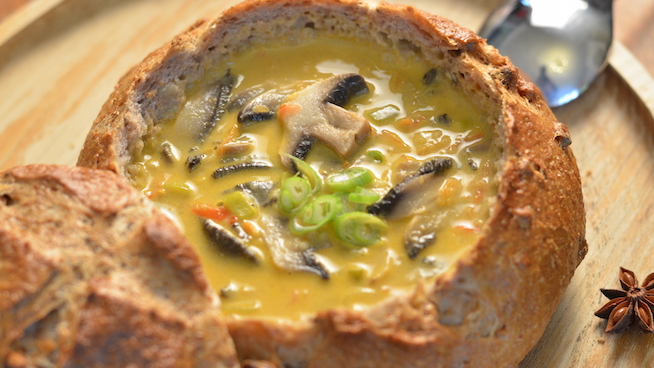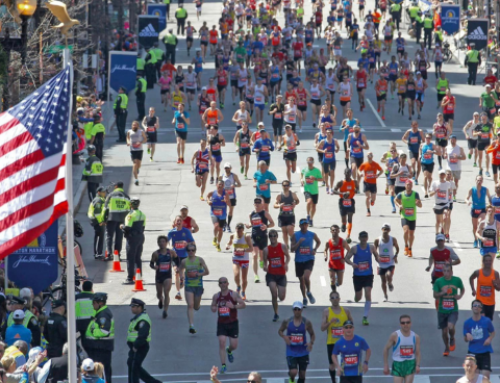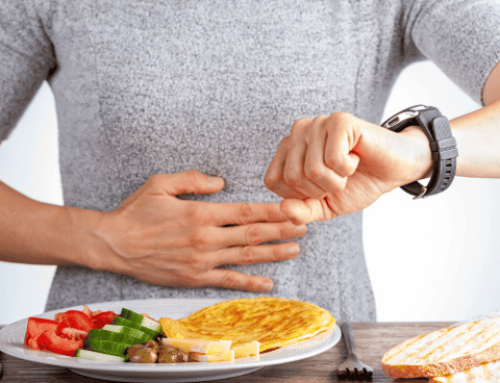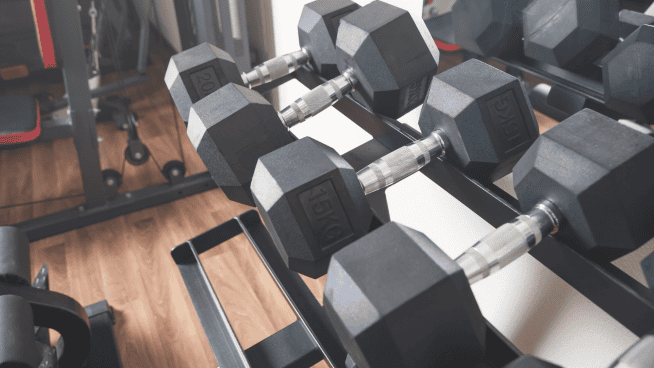Temperatures are dropping and that can only mean one thing—it’s soup season. When the calendar flips to the colder months, soup becomes a go-to meal for many people. It’s warm, it’s comforting and it’s easy to make. Plus there’s some truth to the idea that soup can help you feel better.
But for all these benefits, not every soup deserves to be in your bowl. You might not be aware of it, but certain soups are little more than liquid junk food. To help you know what choices should and should not find their way into your soup bowl this season, here are the five unhealthiest varieties of soup.
1. Steer Clear of Chowders and Bisques
This might enrage New Englanders, but the truth is that chowder is not a terribly healthy soup selection. Although it is made in a variety of ways (clam, corn, etc.), it’s almost always made with a cream or milk base—which results in a high amount of calories and fat.
RELATED: 6 Foods with Wildly Unrealistic Serving Sizes
A 1-cup serving of Campbell’s Chunky New England Clam Chowder contains 180 calories, 10 grams of fat, 13 percent of your daily saturated fat and 890 mg of sodium. That doesn’t sound super terrible, but a 1-cup serving is ridiculously small. You’re more likely to eat 2 cups, and when you double those nutrition numbers to reflect the portion you’re actually ceating, things get ugly. It’s the same story with bisques—their cream-base typically sabotages their nutrition.
2. Broccoli and Cheese are Bad News
If a soup has broccoli in it, it’s gotta be healthy, right? Nope—at least not when it’s followed by “cheese.” In most broccoli and cheese soups, the amount of broccoli is typically pretty measly—not nearly enough to make up for the negative nutritional aspects of the other ingredients. One cup of Broccoli Cheddar soup at Zoup! packs a whopping 290 calories, 20 grams of fat, 60 percent of your daily saturated fat and 1190 mg of sodium. That’s more fat than you get in four Twinkies! Yikes.
3. Be Wary of Chili
Chili certainly makes for a delicious cold-weather meal, but its nutrition can vary wildly depending on how it’s prepared. A serving of Progresso’s Pork and Beef Chili with Beans contains 320 calories, 20 grams of fat, 35 percent of your daily saturated fat and 670 mg of sodium—numbers that don’t categorize it as a “healthy” choice. Turkey chili options can be a good if you want a low-fat option.
RELATED: 5 Foods That Are Stunningly High in Sodium
4. Watch Out for Potato Soups
Potato soup sounds like it could be halfway decent for you. Potatoes are good sources of fiber, potassium and vitamin C. But in reality, they’re rarely a source of good nutrition. A big reason for this is that they’re usually made with cream and frequently include not-so-healthy additions like bacon and cheese. Campbell’s Baked Potato with Cheddar and Bacon Bits packs 190 calories, 9 grams of fat and 790 mg of sodium.
5. Give Bread Bowls the Boot
It doesn’t matter what kind of soup you choose if you put it in a bread bowl. Odds are, it won’t be very good for you. The sourdough Bread Bowl at Panera instantly adds 660 calories and 1340 mg of sodium to your meal. That’s the same amount of sodium you’d consume if you downed 82 Tostitos! A Bread Bowl might be OK as a treat every once in awhile, but letting it become a regular menu item is a big mistake.
The Alternatives
Now that you know which soups to skip, let’s review the good choices. As with most foods, the best way to control the nutrition of your soup is to make it yourself.
A great way to make your own soup is to buy a low-sodium broth and include ingredients like lean ground beef, potatoes, peppers, carrots, lean chicken breast, onions, egg noodles, beans and other healthy choices. You can fully customize your soup and control every aspect of its nutrition. Honestly, it’s pretty tough to make a bad soup if you use ingredients you enjoy. If you’re looking for additional health benefits, you can make bone broth soup.
RELATED: Bone Broth Breakdown: Should You Eat This “Super Soup”?
If you’re going store-bought, avoid cream-based soups and stick with veggie-based or bean soups. As always, it doesn’t matter how healthy something looks if its nutritional facts are subpar. Read nutrition labels and peek at the serving size before you reach a conclusion about the health benefits of a soup.
RECOMMENDED FOR YOU
MOST POPULAR
Temperatures are dropping and that can only mean one thing—it’s soup season. When the calendar flips to the colder months, soup becomes a go-to meal for many people. It’s warm, it’s comforting and it’s easy to make. Plus there’s some truth to the idea that soup can help you feel better.
But for all these benefits, not every soup deserves to be in your bowl. You might not be aware of it, but certain soups are little more than liquid junk food. To help you know what choices should and should not find their way into your soup bowl this season, here are the five unhealthiest varieties of soup.
1. Steer Clear of Chowders and Bisques
This might enrage New Englanders, but the truth is that chowder is not a terribly healthy soup selection. Although it is made in a variety of ways (clam, corn, etc.), it’s almost always made with a cream or milk base—which results in a high amount of calories and fat.
RELATED: 6 Foods with Wildly Unrealistic Serving Sizes
A 1-cup serving of Campbell’s Chunky New England Clam Chowder contains 180 calories, 10 grams of fat, 13 percent of your daily saturated fat and 890 mg of sodium. That doesn’t sound super terrible, but a 1-cup serving is ridiculously small. You’re more likely to eat 2 cups, and when you double those nutrition numbers to reflect the portion you’re actually ceating, things get ugly. It’s the same story with bisques—their cream-base typically sabotages their nutrition.
2. Broccoli and Cheese are Bad News
If a soup has broccoli in it, it’s gotta be healthy, right? Nope—at least not when it’s followed by “cheese.” In most broccoli and cheese soups, the amount of broccoli is typically pretty measly—not nearly enough to make up for the negative nutritional aspects of the other ingredients. One cup of Broccoli Cheddar soup at Zoup! packs a whopping 290 calories, 20 grams of fat, 60 percent of your daily saturated fat and 1190 mg of sodium. That’s more fat than you get in four Twinkies! Yikes.
3. Be Wary of Chili
Chili certainly makes for a delicious cold-weather meal, but its nutrition can vary wildly depending on how it’s prepared. A serving of Progresso’s Pork and Beef Chili with Beans contains 320 calories, 20 grams of fat, 35 percent of your daily saturated fat and 670 mg of sodium—numbers that don’t categorize it as a “healthy” choice. Turkey chili options can be a good if you want a low-fat option.
RELATED: 5 Foods That Are Stunningly High in Sodium
4. Watch Out for Potato Soups
Potato soup sounds like it could be halfway decent for you. Potatoes are good sources of fiber, potassium and vitamin C. But in reality, they’re rarely a source of good nutrition. A big reason for this is that they’re usually made with cream and frequently include not-so-healthy additions like bacon and cheese. Campbell’s Baked Potato with Cheddar and Bacon Bits packs 190 calories, 9 grams of fat and 790 mg of sodium.
5. Give Bread Bowls the Boot
It doesn’t matter what kind of soup you choose if you put it in a bread bowl. Odds are, it won’t be very good for you. The sourdough Bread Bowl at Panera instantly adds 660 calories and 1340 mg of sodium to your meal. That’s the same amount of sodium you’d consume if you downed 82 Tostitos! A Bread Bowl might be OK as a treat every once in awhile, but letting it become a regular menu item is a big mistake.
The Alternatives
Now that you know which soups to skip, let’s review the good choices. As with most foods, the best way to control the nutrition of your soup is to make it yourself.
A great way to make your own soup is to buy a low-sodium broth and include ingredients like lean ground beef, potatoes, peppers, carrots, lean chicken breast, onions, egg noodles, beans and other healthy choices. You can fully customize your soup and control every aspect of its nutrition. Honestly, it’s pretty tough to make a bad soup if you use ingredients you enjoy. If you’re looking for additional health benefits, you can make bone broth soup.
RELATED: Bone Broth Breakdown: Should You Eat This “Super Soup”?
If you’re going store-bought, avoid cream-based soups and stick with veggie-based or bean soups. As always, it doesn’t matter how healthy something looks if its nutritional facts are subpar. Read nutrition labels and peek at the serving size before you reach a conclusion about the health benefits of a soup.

